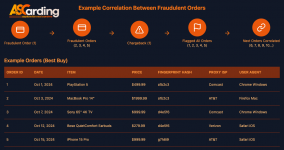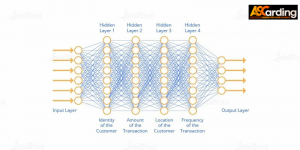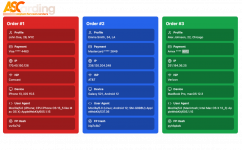d0ctrine
Diamond
- Joined
- 17.08.24
- Messages
- 107
- Reaction score
- 4,008
- Points
- 93

Ever had this happen? You find a sweet spot - a method or site thats printing money. For days or weeks youre riding high carding like a boss. Then suddenly the well runs dry. Your transactions start tanking orders get cancelled left and right and youre left wondering what the fuck happened.
Most newbies think the sites patched their holes or blocked their BINs. But thats rarely the real story. The truth? Youve been training their AI to sniff out your bullshit without even realizing it.

These fraud detection systems arent just dumb algorithms checking if your address matches your IP. Theyre sophisticated learning machines evolving with every transaction that passes through them. Even your successful hits are feeding the beast making it smarter and hungrier for your next attempt.
Youre leaving a trail of digital breadcrumbs and then acting surprised when the AI follows it straight to your virtual doorstep. Every card you swipe every order you place is another lesson in "How to Catch a Carder 101" and youre the fucking professor.
In this guide were gonna dissect how these AI systems learn from you and more importantly how to stay a step ahead. Well cover ways to keep your patterns unpredictable techniques to mix up your approach and strategies to avoid setting off those statistical alarm bells.
Lets get one thing straight - theres no magic bullet that lets you hit the same site forever. That fairy tale doesnt exist. This is about understanding the game at a deeper level so you can play it smarter and keep your pockets lined while other carders are bitching about their "patched" methods.
Time to elevate your game. Class is in session and today were teaching you how to outsmart the machines that are learning to outsmart you. Pay attention or get left behind.
The Life Cycle of A Fraudulent Transaction
Lets talk about how your carded transactions come back to bite you in the ass. Weve already covered what data gets collected in my "Bypassing AI Fraud Systems" guide. Today were focusing on how these AI systems connect the dots and why one fuck-up can burn your whole operation.

Heres the deal: Every time you card something youre not just risking that one transaction. Youre potentially linking every transaction youve ever done and everything youll do in the future. These AI systems never throw anything away and theyre constantly re-analyzing old data.
The moment you hit that "Place Order" button the AI starts building a web of connections. Its linking your card details device fingerprint IP address browsing patterns and a ton of other data points. And it doesnt stop there. Its comparing this transaction to every other order in its database looking for similarities.
Now heres where it gets really fucked: Chargebacks. When a chargeback hits its like setting off a nuke in the AIs system. Suddenly that one transaction isnt just flagged as fraud. The AI goes into overdrive combing through its entire history and flagging anything remotely similar.
This is why you can be hitting a site consistently for weeks and then suddenly nothing works. Its not just that one order that got charged back thats causing problems. The chargeback triggered a cascade effect. The AI has now linked that fraudulent transaction to every other order youve placed with similar characteristics. So the moment the first order you did charges back/disputes, it starts retroactively feeding to the neural network risks for transactions correlated to you, further adding more data to its arsenal.

And Im not just talking about obvious shit like the same card or email. These systems are smart enough to spot patterns in things like your browsing behavior the time of day you place orders or even the specific combination of items you buy. One slip-up and suddenly every transaction that shares any similarities is under scrutiny.
This cascade effect is why changing your email or using a new drop address isnt enough. The AI has already built a profile of your behavior. Its not looking at individual data points anymore its analyzing patterns. Your entire method of operation becomes your digital fingerprint.
This process never stops. That chargeback from six months ago? Its still influencing how the AI views your current transactions. Every new piece of data every new transaction is being compared against this ever-growing web of connections.
So whats the takeaway here? Every. Fucking. Transaction. Matters. Youre not just trying to get one order through. Youre playing a long game against a system with a perfect memory and an ever-evolving understanding of fraud patterns.
Compartmentalizing Transactions
The key to not getting caught by AI fraud systems is understanding that every transaction you make is potentially linked. Its like youre weaving a web with each order and once that web gets burned you need to move to a whole new corner of the digital universe.
This doesnt just apply to your run-of-the-mill CVV carding. Even when youre working with logs you need to treat each session like its in a vacuum. Every successful hit is leaving breadcrumbs for the AI. Your job is to make those breadcrumbs lead nowhere.
Heres the deal: once your success rate starts to dip dont sit there wondering what went wrong. Be proactive. Rotate your proxy providers regularly. Switch up your antidetect setup. Change everything you can to make sure your next transaction has zero correlation with all the shit youve done before.
Give your best shot in changing most if not all data points they can correlate between how youre transacting now to how youve transacted before. Different browser fingerprints new IP ranges varied spending patterns - the whole thing. You want each carding session to look like its coming from a completely different person.

Think of it like youre running a crew of international spies. Each operation needs to be isolated with its own set of tools identities and methods. If one goes down the rest stay clean. Thats the level of compartmentalization you need to be operating at.
And dont reuse successful patterns. Just because a certain combination of proxy antidetect and card type or BIN worked once doesnt mean you should keep using it. Mix it up. Keep the AI guessing.
Remember these AI systems are constantly learning constantly evolving. Theyre not just looking at individual data points; theyre analyzing patterns across millions of transactions. Your job is to be so random so unpredictable that you dont even register as a blip on their radar.
So next time youre setting up for a carding session ask yourself: "Is this different enough from my last hit?" If theres even a shadow of a doubt change it up. New proxy new antidetect profile new everything. Treat each session like its your first and last. Because in this game the moment you get comfortable youre already fucked.
The Trick With Canvas
One special trick I keep telling people who ask me has to do with their antidetects canvas and client rects. Should it be set to noise or real? The answer is it depends. And heres why:
When youre hitting a site for the first time or spreading your carding across multiple platforms real canvas is your best friend. Why? Because these AI systems have a massive database of legitimate canvas fingerprints. Most devices with the same architecture and GPU share identical canvas prints. By showing a real accurate canvas of your device youre essentially blending in with millions of legit users.
Video:
These fraud detection systems have seen more device fingerprints than you can imagine. They know what a real canvas looks like for every combination of hardware out there. When you show up with a genuine canvas print youre telling the AI "Hey look Im just another boring user with a standard device." Its like having a solid alibi without even trying.
On the flip side using noise (where your antidetect randomizes the canvas FP) can actually raise red flags. Why? Because youre likely generating a canvas fingerprint that doesnt match anything in their massive database. Youre not blending in youre sticking out.
But heres where it gets tricky: If youre repeatedly hitting the same site the rules change. In this scenario randomized canvas becomes your new best friend. Let me break it down for you:
Lets say youre carding Amazon. First order with a real canvas - your fraud score is a low 20. Using a generated canvas might bump you up to 45 (bit sketchy but still workable). Logically youd stick with the real canvas right?
Wrong.
Every time you use that real canvas youre leaving the same digital fingerprint. Its like committing crimes while wearing the same unique shoes to every job. Day after day week after week youre building a profile. That initial fraud score of 20? It creeps up to 30 then 40 then 50. Before you know it none of your transactions are going through.
This is where noise saves your ass. Sure you might start with a higher fraud score but heres the thing - its different every time. Youre essentially wearing a new pair of shoes for each job. The AI cant build a consistent profile because youre never the same twice.

So whats the takeaway? If youre spreading your carding across multiple sites or just dipping your toes go with real canvas. Blend in with the crowd. But if youre hammering one site repeatedly? Noise is your solution. Youre trading a slightly higher initial risk for long-term sustainability.
Closing Thoughts
The AI fraud detection game is evolving rapidly. What worked yesterday might get you burned tomorrow. The key to staying ahead? Constant vigilance.
Every transaction every mouse click is potentially giving these systems more ammo to use against you. Your job isnt just to card - its to be a digital chameleon constantly shifting never settling into a pattern.
This isnt just about making money anymore. Its about outsmarting systems designed to catch transactions from people like you. Its a high-stakes game of cat and mouse and the cats are getting smarter every day.
Class dismissed. Now go forth and card like your freedom depends on it - because it fucking does.


